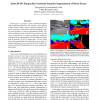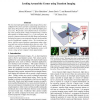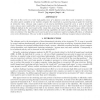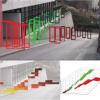146
Voted
CVPR
2012
IEEE
13 years 3 months ago
2012
IEEE
In this paper we consider the problem of recovering the free space of an indoor scene from its single image. We show that exploiting the box like geometric structure of furniture ...
143
Voted
CVPR
2012
IEEE
13 years 3 months ago
2012
IEEE
In this paper we propose a novel Conditional Random Field (CRF) formulation for the semantic scene labeling problem which is able to enforce temporal consistency between consecuti...
126
Voted
ICCV
2011
IEEE
14 years 20 days ago
2011
IEEE
A class of techniques in computer vision and graphics is based on capturing multiple images of a scene under different illumination conditions. These techniques explore variations...
130
click to vote
CVPR
2011
IEEE
14 years 8 months ago
2011
IEEE
We present a human-centric paradigm for scene understanding. Our approach goes beyond estimating 3D scene geometry and predicts the “workspace” of a human which is represented...
ICCV
2009
IEEE
14 years 10 months ago
2009
IEEE
We show that multi-path analysis using images from a timeof-flight (ToF) camera provides a tantalizing opportunity to infer about 3D geometry of not only visible but hidden parts ...
109
Voted
CGF
2002
15 years 14 days ago
2002
Projective texture mapping is used to project a texture map onto scene geometry. It has been used in many applications, since it eliminates the assignment of fixed texture coordin...
114
click to vote
VCIP
2003
15 years 2 months ago
2003
The aim of this work is to render high-quality views of a dynamic scene from novel viewpoints in real-time. An online system available at our institute computes the visual hull as...
104
Voted
VISUALIZATION
1999
IEEE
15 years 5 months ago
1999
IEEE
We present a new rendering technique, termed LOD-sprite rendering, which uses a combination of a level-of-detail (LOD) representation of the scene together with reusing image spri...
116
click to vote
ECCV
2010
Springer
15 years 5 months ago
2010
Springer
This paper describes a method to recover scene geometry from the second-bounce of light transport. We show that form factors (up to a scaling ambiguity) can be derived from the sec...
140
Voted
Publication
We present an online learning approach for robustly combining unreliable
observations from a pedestrian detector to estimate the rough 3D scene geometry
from video sequences of a...




